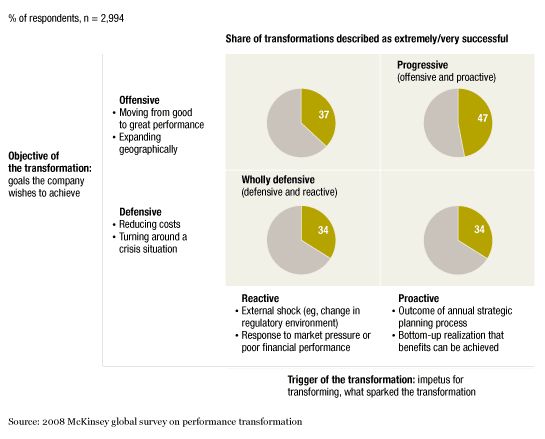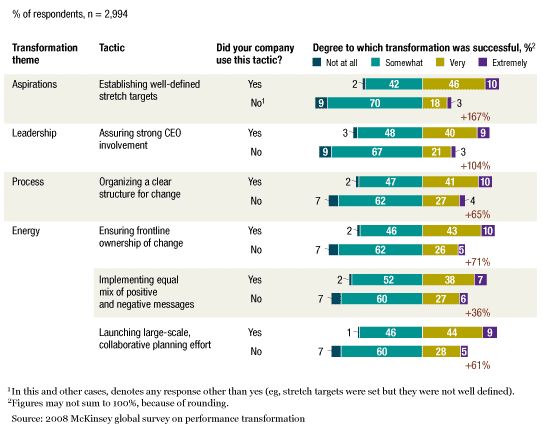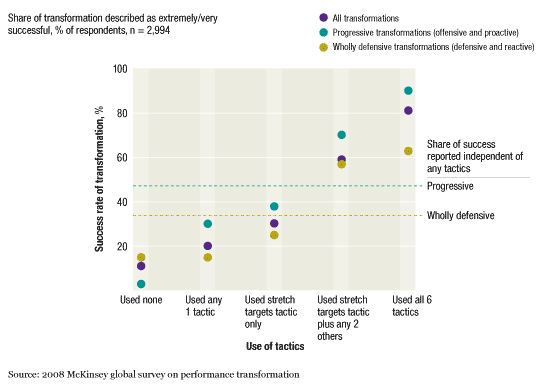It’s relatively rare for transformation programs to succeed; many surveys, including our own, put the success rate at less than 40 percent.1 Our recent research, however, underscores the fact that certain tactics promote successful outcomes. The most important tactics are setting clear and high aspirations and targets, exercising strong leadership from the top, creating an unambiguous structure for the transformation, and maintaining energy and involvement throughout the organization.2 Companies that used all of these tactics succeeded more than 80 percent of the time.3
The same research also shows that what we call defensive transformations (those undertaken to stem trouble) have lower success rates than progressive ones (launched, for instance, to boost growth or to move from good to great performance). This finding seems to contradict the common wisdom that it is hardest to transform a company when it lacks an acute and apparent need for change. In our experience, however, while employees are more likely to see the need for change when a company is in crisis, this advantage is outweighed by difficult circumstances.
Moreover, we find that many companies under pressure do not make use of proven tactics for implementing change. Instead, they tend toward secrecy and may have small groups of troubleshooters plan the transformation rather than involve the whole organization and set clear, widely communicated aspirations and targets. Our research shows that companies using proven change tactics when they undertake defensive transformations boost their chances of success considerably.
As more and more companies face pressure to transform their performance, it is crucial for them to understand how proven change tactics increase their chances of success and how to avoid approaches that undermine many transformation efforts.
Building successful transformations
We surveyed executives from around the world about recent corporate transformation processes they had experienced. These transformations had a wide range of objectives. Some were clearly undertaken on the offense, such as moving from good to great performance or expanding geographically; others were clearly defensive, such as reducing costs or turning around a crisis. Some—for instance, merger integration and preparing for privatization—didn’t fall clearly into either category. Slightly more than a third of all respondents said that their companies had been very or extremely successful at hitting the target.
To compare the success rates of transformations begun for clearly offensive and defensive reasons, we limited the sample to them and refined the comparison by taking into account how they were triggered. Some were undertaken in reaction to external shocks, market pressure, or poor financial performance; others were initiated proactively. The most successful transformations are those that are both offensive and proactive—we call them “progressive”—which have a 47 percent success rate. Defensive transformations have a 34 percent rate of success (Exhibit 1).4
Defensive versus progressive

Two findings should encourage leaders who must now mount a defensive effort: the tactics used in all successful transformations, regardless of type, are nearly identical, and in defensive transformations that fail, those tactics are rarely used.5 The key successful tactics that our research highlights (Exhibit 2) can be organized in four well-known transformation design themes: aspirations (well-defined stretch targets), leadership (strong CEO involvement), process (a clear structure for the transformation), and energy (for instance, efforts to ensure frontline ownership of change). It’s not enough simply to bring these tactics to bear, of course; executing them well is the other half of the battle (see sidebar, “Successful transformations, step-by-step”).
Effective tactics

Even more interesting, the more of these tactics companies use, the likelier a successful conclusion, regardless of context (Exhibit 3). Setting a well-defined stretch target is the single tactic most tied to success—indeed, 90 percent of transformations that lack such a target fail. Each additional tactic increases the likelihood of success.
Increasing the odds

Why some companies get it wrong
It’s critical for companies starting defensive change programs to rely on proven tactics, yet responses to these situations frequently fall short of best practice. Even though employees, investors, and others expect—indeed welcome—fundamental change from such companies, other factors lead them in counterproductive directions.
Having a leader who is open about a company’s problems is necessary for real change to happen at all. CEO Om Prakash Bhatt, who took over the State Bank of India in 2006 when it was foundering, remarked that “no one ever told executives the real state of the company,” so they did not see the need for change. By explaining the truth to them, Bhatt laid a foundation for a fundamental transformation. (For more details, see “Remaking a government-owned giant: An interview with the chairman of the State Bank of India.”) That bias toward secrecy, our experience at other companies indicates, may stem from fear of failure, of confrontation with employees, or of bad press that could make problems worse.
Yet secrecy itself tends to compound problems, often by ensuring that the front line isn’t involved or energized. One infrastructure maintenance company facing collapse, for example, chose a small, select team to design a new corporate organization. Over six months, that team worked in almost complete secrecy and isolation. By the end, rumors were rampant throughout the company, and the vast majority of its employees, who never felt engaged or consulted, rejected the team’s solutions. This company was responsible for a number of serious failures of public infrastructure, most of the senior leaders were fired, and the company was taken over.
Finally—and perhaps most important now—many companies focus so closely on responding to a crisis in the short term that they fail to step back and plan their longer-term transformation in a way that would produce the best results. Instead, these companies tend to move from one short-term cost-cutting initiative to the next, without setting or communicating a clear, stretch aspiration.
Getting out of trouble
Some companies in defensive situations have avoided these traps and found ways to use most or all of the tactics tied to successful transformations in order to achieve a radically improved position.
Poste Italiane
In 1998, Corrado Passera became the CEO of Poste Italiane, Italy’s state-owned postal service. The company, which hadn’t made a profit in more than half a century, was near financial collapse, with a loss of €1 billion in 1998. Revenue had fallen 8 percent in a single year because of moves by local and global competitors, and the company was under broad public pressure from consumers dissatisfied with its service.
Passera began by proposing, in his words, “a mission that is, at one level, a dream but is also achievable. Too much of a dream, and people will not believe in it. Too much emphasis on survival, and they will not accept the sacrifices.” He set two stretch targets: becoming one of Europe’s best post offices and Italy’s largest financial-services organization. Passera involved the entire company by setting goals—for service quality, operational efficiency, and commercial effectiveness—that could be tracked at each post office counter. He then traveled to post offices around the country, explaining to managers and employees alike the targets and the plans to reach them. As for the significance of his own role, he noted that “you have to put your face in front of the people if you want them to follow you.”
Over two years, Poste Italiane completely redesigned its frontline operations—for instance, improving the customer’s physical environment, revamping the computer system, and training 60,000 employees to meet the new service standards. The company tested specific improvements on the front line, and those generating the greatest benefit were scaled up first, in the areas deemed most difficult to change. For all employees, this tactic highlighted the possibility of a real transformation.
Eventually, the time customers spent in lines fell by 50 percent—an improvement resulting in part from operational efficiencies that allowed more than 15,000 employees to move from the back office to the front line and in part from a 30 percent increase in transactions per counter clerk. As a result of those changes, business hours rose by more than 12 percent at no extra cost, and with 10,000 fewer staff. Poste Italiane also became Italy’s third-largest insurance provider, and revenue at postal counters increased by 20 percent. The company made its first profit under Passera in 2001 and has remained profitable ever since.6
Malaysia Airlines
Idris Jala’s leadership of Malaysia Airlines offers an example of how strong-minded and visible CEOs can engage the staff through collaborative planning when they set a clear structure for change. In 2005, as Jala became CEO, the company had less than four months’ cash on hand. By focusing solely on the profit-and-loss statement, he created a turnaround plan setting forth what he called the “seemingly impossible” goals that could save the company.
Jala engaged knowledgeable frontline and managerial employees in what he called “laborat-ories,” where they explored problems such as unprofitable routes. In this way, he found a device to make the whole company believe that the necessary changes were possible. Some problems couldn’t be solved; as Jala put it, “We had a team looking at the Kuala Lumpur–Manchester route. The team couldn’t fix it. To be profitable, we needed 40 percent more passengers than we had capacity for. What would we do? Tie the passengers on the wings? After we went through a full analysis, everyone on the team knew that the route couldn’t be fixed. They all knew that they were out of a job.” But the company saved enough routes and made enough changes, with the full support of employees and other stakeholders, to save itself. (For more details, see “Turning around a struggling airline: An interview with the CEO of Malaysia Airlines.”)
A global retailer in Brazil
For decades, the Brazilian subsidiary of a global retailer was number one in its field, both in market share and profitability, as well as top of mind for consumers. Yet by 2004, the position of this subsidiary had deteriorated so far that more than half of its stores operated at a serious loss. A new CEO was appointed with a mandate to fix or sell. His actions highlight the importance of relentlessly training the top team to lead effectively, establishing collaborative-planning processes, and making the top 250 executives think and behave like owners by embedding the spirit and mechanisms of accountability for meeting clear stretch goals.
The new CEO decided on the theme of the overall transformation—to “recover the place that belongs to us.” He set high targets: to post a positive EBIT7 in the first year and then earn one more point of EBIT annually for three years, to open ten new stores a year (up from two in three years), and to ensure that the company was once again the consumers’ top-of-mind retailer. He also stressed “happy employees for happy consumers,” “lower costs for lower prices,” and three other cross-cutting themes embracing the key sources of value and employee engagement. For each of these themes, the CEO and his team developed tactical plans with result-oriented metrics, such as closing hopeless stores, improving the effectiveness of promotions, and opening new stores more quickly.
Planning began with the executive committee, which developed the initial strategic and tactical plans and took steps to improve the effectiveness of its individual members and of their work as a team. They wrote and signed a leadership charter that included such points as accountability for results, resolving issues publicly rather than behind closed doors, and the imperative for all members to address their own shortcomings before those of others. The charter, introduced throughout the organization, became a tool for changing the culture to support the performance transformation. What’s more, the top team held many workshops to gather the employees’ contributions to its initial strategic and tactical plans, to generate buy-in, and to instill the new mind-sets, symbols, and language. This collaborative input was included in the final plans in areas such as new stock layouts and replenishment systems.
Within two years, earnings had increased by $100 million, bringing the company out of the red. Within three, it had surpassed its rivals’ average profitability and received from its corporate parent the largest check any subsidiary had gotten in seven years, to accelerate expansion and acquire a local rival. Today, five years into the transformation journey, the subsidiary enjoys an enviable market and financial position and is a central growth engine for its global parent.
Lessons for today
Companies now face an unprecedented credit and market crisis. Many struggle with cash shortages, steeply decreasing sales, and difficulties predicting even the near-term future. But as the examples above show, a company can turn itself around in the most dire situations, even when there isn’t much time. Taking shortcuts—for instance, putting insufficient effort into communicating or focusing on small, short-term changes—only deepens the problems.
Instead, senior leaders must set clear goals that can make a company face reality; establish an unambiguous and inspirational course for change, with high targets and straightforward milestones; and then do whatever it takes to communicate with and engage the organization as a whole. No single tactic will lead to success; rather, each company must find the right combination of tactics and then execute all of them well. By doing so, it can markedly increase the chances that it will transform itself successfully, even in the worst of times.